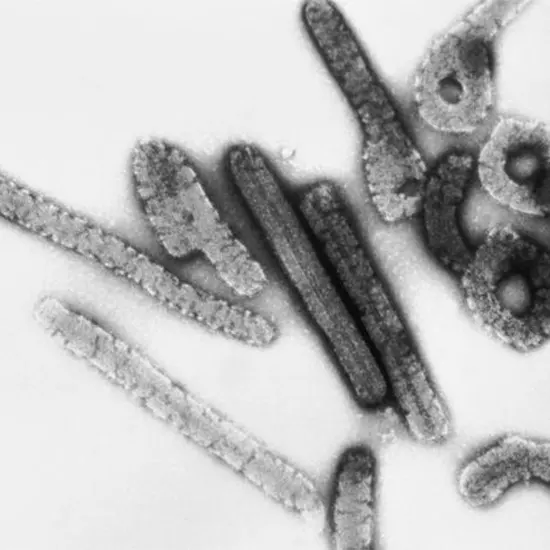
The Ebola virus and the rare and contagious Marburg hemorrhagic fever (MHF) virus are both members of the family Filoviridae. When outbreaks occurred concurrently in the German cities of Marburg and Frankfurt, as well as in...
The Ebola virus and the rare and contagious Marburg hemorrhagic fever (MHF) virus are both members of the family Filoviridae. When outbreaks occurred concurrently in the German cities of Marburg and Frankfurt, as well as in Belgrade, Serbia (then Yugoslavia), and in several labs in Germany and the UK, MHF was first discovered in 1967.
The Marburg virus, which is considered to have first infected fruit bats or primates before spreading to humans, is what causes the illness.
Genetic Research Offers New Hope Against Marburg Hemorrhagic Fever
The virus that causes Marburg hemorrhagic fever is called the Marburg virus and is a member of the Filoviridae family (MHF). Like other members of the Filoviridae family, the Marburg virus is an encapsulated negative-stranded RNA virus. About 19 kb in length, the virus's single strand of RNA genome includes the genetic code for seven structural proteins, including the RNA-dependent RNA polymerase, viral protein 35 (VP35), glycoprotein (GP), and VP30 (L).
The Marburg virus is highly genetically diverse and has a large number of strains and subtypes. African fruit bats of various species have been identified to carry the virus, which is thought to have originated in fruit bats.
The Marburg virus has undergone many iterations of adaptation to various host species, according to genetic research of distinct strains of the virus. Numerous genetic factors that may contribute Ultrasound to the virulence and pathogenesis of the virus have been identified through studies. These factors include mutations in the GP gene, which are linked to increased binding affinity to human cells, and mutations in the NP gene, which are linked to increased viral replication and immune evasion.
To create efficient diagnostic procedures, therapeutic regimens, and disease-prevention vaccines, it is critical to comprehend the genetics of the Marburg virus. Developing solutions to stop and manage MHF outbreaks requires ongoing research into the genetic diversity and evolution of the virus.
Mapping Out the Life Cycle of Marburg Hemorrhagic Fever for Better Preparedness
The main phases of the Marburg virus's life cycle are as follows:
Entry and attachment : Via its surface glycoprotein, the Marburg virus binds to certain receptors on the surface of host cells (GP). Within the host cell, endocytosis transports the virus to endosomes after it has attached.
Fusion and uncoating : The Marburg virus GP changes its shape inside endosomes, enabling it to fuse with the membrane and release the viral DNA into the cytoplasm of the host cell. The viral RNA is then released from the capsid and transported to the host cell's nucleus.
Replication and transcription : The Marburg virus RNA is converted into mRNA by the machinery of the host cell once it has entered the nucleus. After the viral mRNA has been translated into viral proteins, the newly formed virus particles are put together.
Assembly and budding : At the host cell membrane, the newly manufactured viral parts are put together to form new virus particles. Through budding, the virus particles are then expelled from the host cell and can spread to nearby cells and tissues.
Host immunological response : The host immune system wages an attack on the infection as the virus multiplies and spreads throughout the body. The Marburg virus can, however, inhibit the production of interferon and other antiviral cytokines to evade the host immune response.
The Marburg virus has a complicated life cycle that includes several phases that let it avoid host immune defenses and multiply effectively. To create MHF prevention and treatment plans as well as potent MHF vaccines, it is essential to comprehend the virus' life cycle.
How The Virus Is transmitted?
The Marburg virus can spread primarily through the following channels:
Direct contact with infected animals : Fruit bats are thought to be the primary source of the Marburg virus's natural transmission to humans. Fruit bats are also the virus's most likely reservoir host. Direct contact with other infected animals, such as rodents and monkeys, can also spread the virus to people.
Person-to-person transmission : Humans can contract the Marburg virus by coming into close contact with an infected person's bodily fluids, such as blood, vomit, urine, saliva, or semen. Urine Culture Moreover, the virus can spread through contact with contaminated surfaces such as soiled bedding, clothing, and medical supplies.
Nosocomial transmission : One typical method of spreading MHF is through nosocomial transmission, which is the spread of the virus within healthcare institutions. Due to their intimate contact with diseased people Urine Routine and Microscopy and their body fluids, handling contaminated medical equipment, and handling bodily fluids, healthcare workers are more likely to contract an infection.
Sexual transmission : Male MHF survivors' semen has been found to contain the Marburg virus months after the onset of their symptoms, and in some circumstances, the virus has been documented to be transmitted sexually.
What Can Be The Signs And Symptoms?
The disease advances quickly with a high case fatality rate, and symptoms often appear 5 to 10 days after infection. Some of the most typical MHF warning signs and symptoms are listed below:
Fever : The majority of people with MHF get a high temperature suddenly, frequently exceeding 38.5°C (101.3°F).
Headache : MHF frequently manifests with headaches, which are frequently accompanied by overall malaise and exhaustion.
Muscle pain : MHF patients frequently experience muscle pain, weakness, and exhaustion, which can make it challenging for them to carry out daily tasks.
GI Symptoms : MHF can produce nausea, vomiting, abdominal pain, and diarrhea, which can result in electrolyte imbalances and dehydration.
Hemorrhagic symptoms : The development of hemorrhagic signs, such as bleeding from the gums, nose, and digestive tract as well as ecchymoses (bruising) and petechiae, is the defining characteristic of MHF.
Symptoms of the central nervous system : Some people with MHF may also experience symptoms of the central nervous system, including disorientation, agitation, and seizures.
Shock : MHF may, in extreme circumstances, result in shock, a condition marked by low blood pressure, a rapid heartbeat, and organ failure.
Know The Symptoms, Act Fast: Marburg fever Diagnosis
The following are some essential actions in the MHF diagnosis process:
Clinical assessment : Determining people who may be at risk for MHF requires a complete clinical assessment. The history of travel to locations where the virus is known to be present and contact with sick people or animals should all be obtained by medical professionals.
Laboratory testing : To confirm the diagnosis of MHF, laboratory testing is required. Testing might involve:
Serological tests: These exams look for the presence of Marburg virus antibodies in the blood. These tests, nevertheless, might not be conclusive for a few days after the onset of symptoms.
Molecular tests : Molecular tests, like the polymerase chain reaction (PCR), can find viral RNA in bodily fluids like blood, urine, and or feces. These tests can find the virus early in the disease's progression and are more sensitive than serological assays.
Viral culture : In a specialist laboratory, the virus is isolated from blood or other bodily fluids. However, it can take this approach many days to show results.
Differential diagnosis : Medical professionals must take other conditions into account, such as Ebola virus disease, Lassa fever, and other viral hemorrhagic fevers, that may present with comparable symptoms.
What Can Be The Treatment Options?
The following are some essential elements of MHF treatment:
Supportive care : Fluids and electrolytes may be administered to help control electrolyte imbalances, dehydration, and other symptoms related to MHF.
Management of symptoms : Medicines may be used to treat particular symptoms like pain, fever, and nausea. Blood CBC transfusions and other treatments are options for controlling bleeding.
Infection control : Tight infection control procedures are required to stop the virus from spreading to other people and medical personnel. When caring for infected people, the proper personal protective equipment should be worn and the infected person should be segregated.
Experimental therapies : There are presently no licensed treatments for MHF, however, researchers are looking into novel therapeutics. Antiviral drugs, immunotherapies, and other therapies that focus on the virus or the immune system's response to the virus may be among them.
Supporting interventions : To help people and their families live with the effects of the condition, it may be necessary to provide mental health support, social support, and other interventions.
Be vigilant, catch Marburg fever before it's too late.









